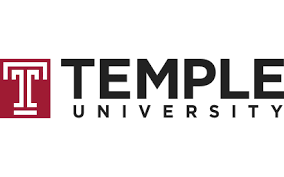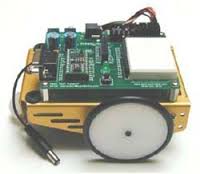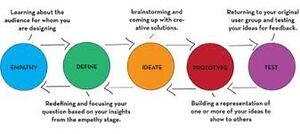Priorities:Temple University Student Priorities
Contents
Project Pitch Videos
2016 Spring
2015 Fall
Projects Proposal - UIF Candidates Spring 2016
Temple University is a huge university with a large amount of I&E resources available for student to utilize. As University Innovation Fellow candidates our goal was to identify the I&E needs of the students, faculty and support staff. We attempted to highlight the areas of concern that hinder the growth of the I&E ecosystem.
When looking at the grand scheme of Temple I&E ecosystem and scoring its stage of development on a scale of 1 - 10, 1 = beginning stage development / 5 = mid stage development / 10 = late stage or fully developed system, we score Temple with a 7 out of 10.
The score of 7 is due a number of reasons including:
Advantages
|
Disadvantages
|
Our projects aim to pinpoint the underlying reasons behind the needs and gaps in the ecosystem and remedy the issues at their core.
Project #1: Get the Freshman Involved - Change the Culture from the Start!
Our goal is to change the culture of the how our students approach I&E opportunities. Over the course of the next four years, we will grow a sustainable I&E ecosystem through each new incoming class. We are developing a system which targets freshman and transfer students during their first week on Temple’s campus. The goal is to show the freshman their latent potential for I&E during their very first week of school.
Our plan is to hold a design thinking introduction event freshman students and transfers. Implementing this program in the beginning of a student’s collegiate career will impact significantly on the student's’ future schedules, thinking and various routines. We intend to introduce students to the design thinking process and the existing I&E ecosystem while their concepts of possible opportunities are still at their highest.
Introduction to Design Thinking Workshop
Milestone 1: Invite students to a one hour planned, controlled, yet simple event that hold up to 20 to 25 students and get them involved with small design thinking challenges that would interest them and tease their minds.
- Tactic 1: Create an organization table and set it outside in the Temple Fest to introduce and show the UIF mission where we expose students with a quick 20 sec intro involving Q/A’s, providing brochure for upcoming events, giveaways..etc.
- Tactic 2: Advertise through flyers, online and even talking about it.
Milestone 2: Stakeholder support
- Tactic 1: Stakeholder meeting
- Tactic 2: Determine available / resource
- Tactic 3: Identify needs and gaps
Milestone 3: Secure an event time and space in welcome week schedule
- Tactic 1: collaborate with welcome week committee
Milestone 4: Acquire mentor and faculty support for mentoring, judging and support
- Tactic 1: Reach out to professors and community mentors for support with judging
Milestone 5: Advertise event to freshman and transfer students
- Tactic 1: Email blast
- Tactic 2: Hold a design thinking workshop / intro for welcome week staff and RA
- create empathy for our cause within the staff by introducing them to the concept and how important it is
- create a buzz by word of mouth from the first people you are supposed to trust
Project #2: Encourage Student to Utilize Existing Resources
One of the needs that we have identified on our campus is the need to encourage students to utilize the existing I&E resources that we have here on campus. Reasons for not utilizing the resources include not knowing the resource existed, the resources not being in a centralized location, fear of failing in public view or disproval of ideas from peers, lack of time to pursue interests due to school workload, andmany students don’t feel like they have the necessary skills is use the equipment in the collaboration spaces. For example, while many students are thrilled to hear that we have 3-D printing capabilities many admitted that they didn’t know how to approach the concept.
By holding several pop-up classes and small competitions we hope to teach some of the skills needed to use the equipment independently while cultivating a desire to explore and experiment. This will also be an excellent time to highlight the location and availability of all the resources that we have. These classes will be open to all temple students.
Skill Development Pop-up ClassesMilestone 1: Stakeholder support
- Tactic 1: Stakeholder meeting with faculty and professors whom have expressed an interest in growing the I&E culture on campus
- Tactic 2: Determine available / resource
- Tactic 3: Identify needs and gaps
Milestone 2: Design a comprehensive pop-class program
- Tactic 1: Create a list of possible activities and identify the needs of each
- Tactic 2: Speak with stakeholders and professor to create a schedule
Milestone 3: Secure a space / equipment for class
- Tactic 1: coordinate with stakeholders and faculty
Milestone 4: Advertize the classes
- Tactic 1: Email blast
- Tactic 2: Flyers and Handout
Project #3: Initiate Campus-wide Collaboration
One of the needs that we have identified on our campus is a lack of campus wide I&E collaboration events. While all colleges agree that it is important to take the learning out of the classroom and experiment with it, there are very few events that allow student to come together to design products and test theories.
Our aim over the next 3 years is to establish a campuswide 3-Day Startup or Design Thinking competition / workshop which will be held each semester. Preferably the event will be held during the first two weeks of each semester. This will ensure that student aren’t overwhelmed with classwork while creating a desire to utilize the available I&E resources throughout the remainder of the semester.
This program will be open to all Temple Students and Alumni. The program encourages networking and places the professionals alongside the students for a mutually beneficial learning experience.
3-Day Startup or 3-Day Design ChallengeMilestone 1: Create a comprehensive 3-Day Startup program
- Tactic 1: Meet individually with a variety of different resources to develop the concept
- Faculty, Students, Aids, Professions from various fields
Milestone 2: Stakeholder support
- Tactic 1: Stakeholder meeting with Deans of each college and other appropriate faculty
- Determine available / resource
- Identify needs and gaps
- Determine funding needs and resources
Milestone 3: Professional support
- Tactic 1: Use stakeholder meeting to develop a contact list of resource outside of campus. Schedule times to talk to these professionals.
- Create a network of professional which will support and enhance the experience
Milestone 4: Student Organization support
- Tactic 1: Schedule meetings or a group meeting with the heads of the student organizations
Milestone 5: Secure a date / space
- Tactic 1: Work with the student activities office to coordinate a target weekend and space large enough to host the activities of the event
Milestone 6: Outline event and gather resources
- Tactic 1: Gather all stakeholder in one meeting or google hangout for a meeting to plan the event
- Itinerary
- Inventory of resources
- Define needs
- Funding
- Roles
Milestone 7: Advertise the Event
- Tactic 1: Email blast
- Tactic 2: Flyers and Handout
- Tactic 3: Pop-up classes
Project #4: Expose Students to the Impact Potential of Design Thinking
One of the programs that we would like to implement is a summer design-thinking program geared to creating positive innovate change in the surrounding community. We would like to partner with a youth organization in the community. Temple has a few established relationships with our own youth leadership council and a relationship with Philadelphia Youth Network (PYN).
The program would be a month long and aimed at creating real change within Philadelphia. The program would submerge its participants into the deep-end of design thinking. The month long program would intense would visit each stage in the Design Thinking process in great detail. The hope is that Temple can cultivate change the community while building lasting relationships with the different communities in Philadelphia.
Summer Design-Thinking Program - Community OutreachMilestone 1: Faculty support
- Tactic 1: Stakeholder meeting with Deans of each college and other appropriate faculty
- Determine available / resource
- Identify needs and gaps
- Determine funding needs and resources
Milestone 2: Idea Development
- Tactic 1: Talk with faculty, staff and students to identify pains and gains and generate ideas for the structure of the event
- Tactic 2: Talk with community leaders and local schools to develop relationships and the idea itself
- Tactic 3: Develop an incentive plan
Milestone 3: Secure a date / space
- Tactic 1: Work with the administration to secure the dates of the event and a viable workspace for the project duration
Milestone 4: Outline event and gather resources
- Tactic 1: Gather all stakeholders in one meeting or google hangout for a meeting to plan the event
- Itinerary
- Inventory of resources
- Define needs
- Funding
- Roles
Milestone 5: Advertise the Event
- Tactic 1: Email blast
- Tactic 2: Flyers and Handouts
- Tactic 3: Pop-up classes
Projects Proposal - UIF Candidates Fall 2015
Project #1: Innovation and Design Center
Temple needs a central place where any student can go to bring their innovative ideas to life. The end-goal of this project is to provide students of any major access to the technology and know-how needed to bring an idea to life. This would include machine equipment training, prototyping classes, and design thinking workshops. The ultimate goal is a student run Innovation and Design Center to serve the Temple community.
- MILESTONE 1: Obtain a space located on Temple’s Main Campus to host this lab. This is aimed to be completed by the start of the Fall 2016 semester.
- TACTIC: This will necessitate a joint lobbying effort from many campus stakeholders. The University’s president will respond to a joint appeal from multiple schools and colleges for this space.
- TACTIC: As a public university, we hope to obtain funding from the Commonwealth of Pennsylvania. Regional and national businesses can be looked to be brought on as sponsors as the center takes shape.
- MILESTONE 2: Recruit students to take introductory design thinking workshops. This will be done by taking advantage of the abundance of design know-how in Temple’s IEI. These short sessions will exposure new students to new ways of thinking. The aim is for this to be completed by May 2016.
- MILESTONE 3: Begin allowing students outside of the Mechanical Engineering Department the ability to obtain training in machine shop equipment. This is aimed to be completed by May 2016
- TACTIC: Certify students with the ability to instruct other students in machine shop equipment. If the end goal is a student run center, the students must be able to certify other students!
Project #2: Offer Noncredit Innovation/Entrepreneurship Courses
The first step students who have an interest in Innovation and Entrepreneurship should be able to take is to explore their newfound interest. The courses they take will be entirely voluntary, and will not affect their GPA or official transcript.
- MILESTONE 1: Professors will begin holding pop-up classes. They can be about any topic of the professor’s choosing and are not required for degree programs. The first pop-up class will be held by Dr. Brookstein of the Engineering College the Spring 2016 semester. It is entitled “Improv in Engineering.”
- TACTIC: We hope Dr. Brookstein’s inaugural pop-up class will spur many more professors to design and hold their own pop-up classes.
- TACTIC: Interaction with students across campus has led to the conclusion that there is a common interest in a pop-up class focused on prototyping. Meeting this student need is essential to the viability of the pop-up course system.
- MILESTONE 2: Begin offering tangible credentials students can use to track their progress. Temple University currently has a non-credit transcript system called DestinyOne. We hope to have the noncredit innovation/entrepreneurship programs we are developing onto this system by Fall of 2016.
- TACTIC: Offer a way for students to track what machines and equipment they complete training in. At first, the focus will be on offering a way for students to master the machines in the Tyler School of Art and Engineering College.
Project #3: University Wide Innovation Network
After interactions with students, faculty, and regional investors/entrepreneurs, it was determined that there is a need for a common network where they all can interact. For instance, students want a place where they can connect with other students to find people with skills they need, advice, or opinions on projects they have in mind.
- MILESTONE 1: Establish an online network where any Temple student, alumni, or faculty can make profiles and connect with one another. The network, however, will be specifically geared towards entrepreneurial topics.
- TACTIC: An official student organization for UIF will be registered with the Main Campus Program Board. From there, it will be possible to utilize Temple’s OwlConnect system for this goal. This is set for completion by November 2015.
- TACTIC: The app/website Slack will be tested for its usability for this networking purpose. This option will allow non-Temple affiliated users to join if approved by the administrator. Moreover, this platform has better mobile capabilities than OwlNetwork.
- MILESTONE 2: Establish a committee of student representatives from multiple schools and colleges throughout Temple that will discuss the current state of Temple’s entrepreneurial ecosystem. The aimed for start date is December 2015.
- TACTIC: The group will start small and slowly add students. To avoid scheduling conflicts, the in person meetings will be held only bi-weekly or monthly.
Project #4: Spotlight Temple Success Stories
The best way to get students involved in innovation and entrepreneurship at Temple will be to make them understand that they are actually capable of pursuing an entrepreneurial dream. This will be done by demonstrating how similar students at Temple succeeded in their endeavours.
- MILESTONE 1: Hold Temple’s first annual information fair for incoming students geared specifically towards spreading information about Temple’s innovation and entrepreneurship resources. This will be called “What IF” where IF is Innovation Fair. UIF will partner with Brandon Study from Temple’s IEI to make this possible. The first fair is going to be held in the Spring of 2016.
- MILESTONE 2: With cooperation from the TUTV station, produce a video series that highlights Temple student-entrepreneur success stories. The focus will be on how Temple helped make their success possible. Episodes will ideally begin being shown by May 2016.
- TACTIC: We will draw on the experience of professor Dwight Carey’s experience working with student entrepreneurs to determine candidates for the show.
- TACTIC: We will hope to display the program throughout the University on the various video screens on campus, from the Engineering Building to the Student Center to the
- MILESTONE 3: A cross-disciplinary design competition will be held at Temple for student teams. As of now, the concept is for various Temple faculty to devise a problem and task student teams of three-four to use their design thinking, prototyping, and innovation skills to address the problem. This will hopefully become an annual event starting in Spring 2017.
- TACTIC: The unique part of the competition will be that teams will be restricted to one member from a specific school or college. For instance, an acceptable team would be one engineering, one art student, and one business student.
Related Links
Temple University Student Priorities"
University Innovation Fellows
Spring 2016:
Fall 2015:
Fall 2010;
Mohamad Ali Niang
Related links




